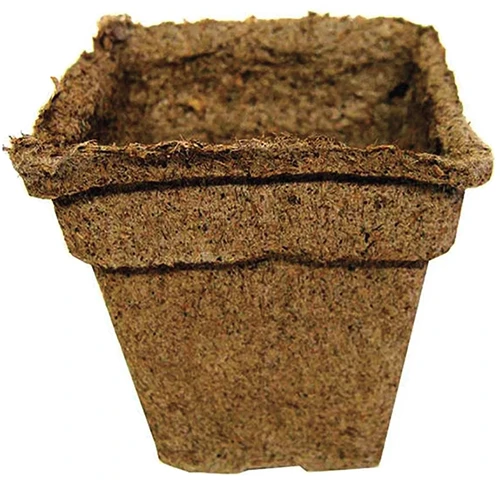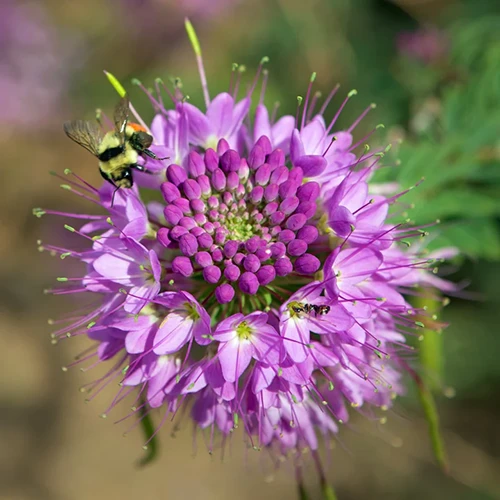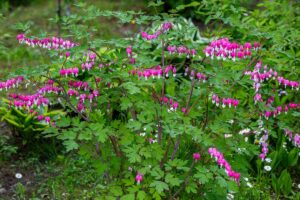Cleomella serrulata
Rocky Mountain bee plant is a low maintenance and showy annual wildflower that’s native to North America, and it’s also a big hit with pollinators!
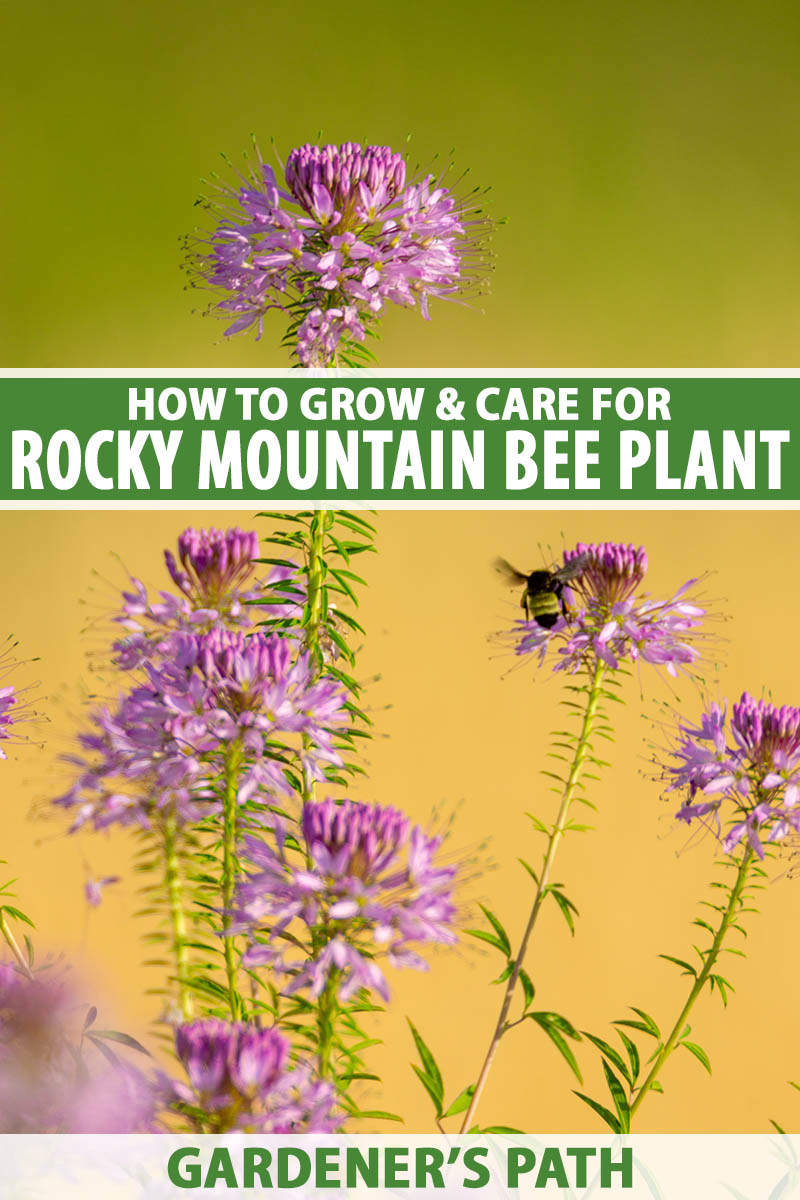
We link to vendors to help you find relevant products. If you buy from one of our links, we may earn a commission.
There are a multitude of reasons to grow this lovely wildflower in your garden or yard.
Whatever your motivation for wanting to grow this showstopper of a summer annual, we’re here to guide you every step of the way.
We’ll discuss everything you’ll need to know to grow and care for this species. We’ll also provide some tips on where to find seeds, and even dig into some of its fascinating ethnobotanical uses!
Here’s what we’ll cover in this article:
What You’ll Learn
What Is Rocky Mountain Bee Plant?
Rocky Mountain bee plant (Cleomella serrulata) is a showy annual wildflower that grows in arid and semi-arid areas and readily reseeds year after year.
Its flower heads are covered with many individual blooms that are usually lavender colored, but are sometimes white or pink.

These inflorescences have a wispy look because of their long stamens, and bloom continuously for several weeks, with clusters of new flowers blooming from bottom to top.
These wildflowers have an upright growth habit and can grow to be quite large, reaching six feet tall or more, depending on the growing conditions.
They have a spread of one to three feet and are anchored by a long taproot.
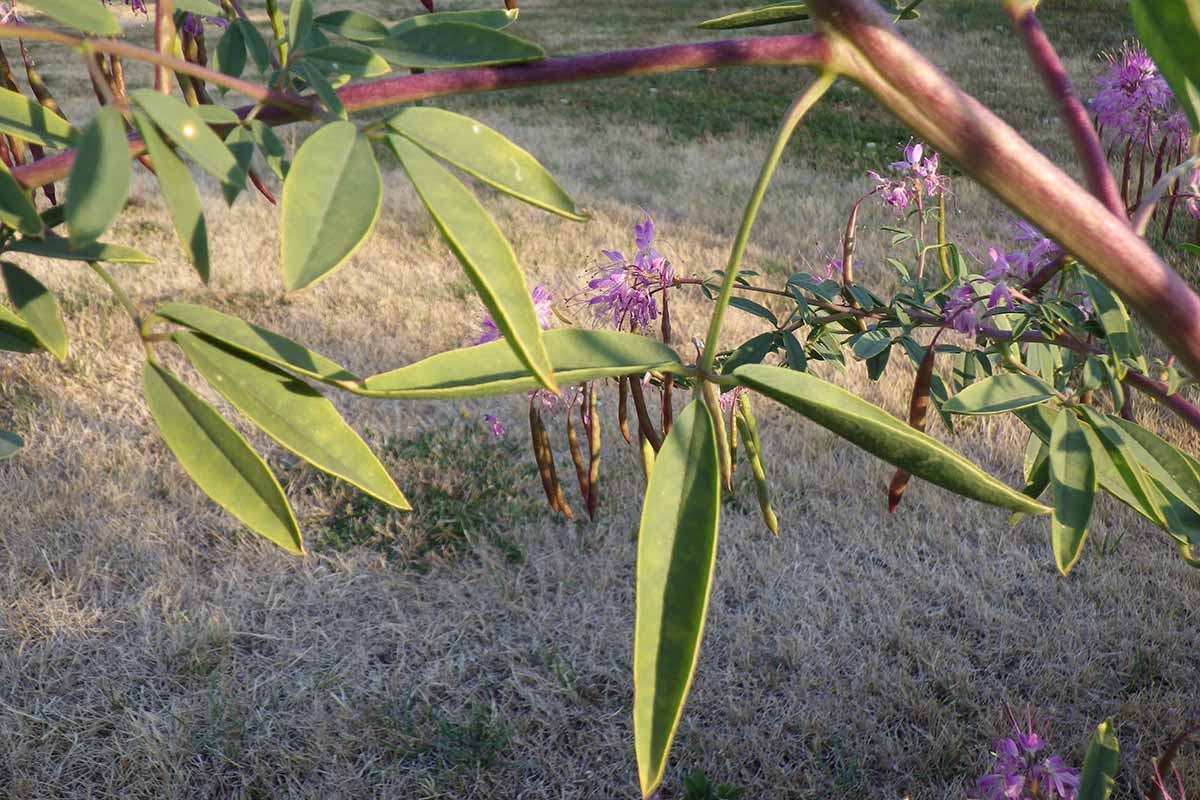
The leaves of this species are arranged on stems in a spiral, and are palmate with three leaflets, while leaf margins are either smooth or finely serrated.
When flowers fade, they give way to long seed pods that can reach between one and four inches long and contain several seeds.
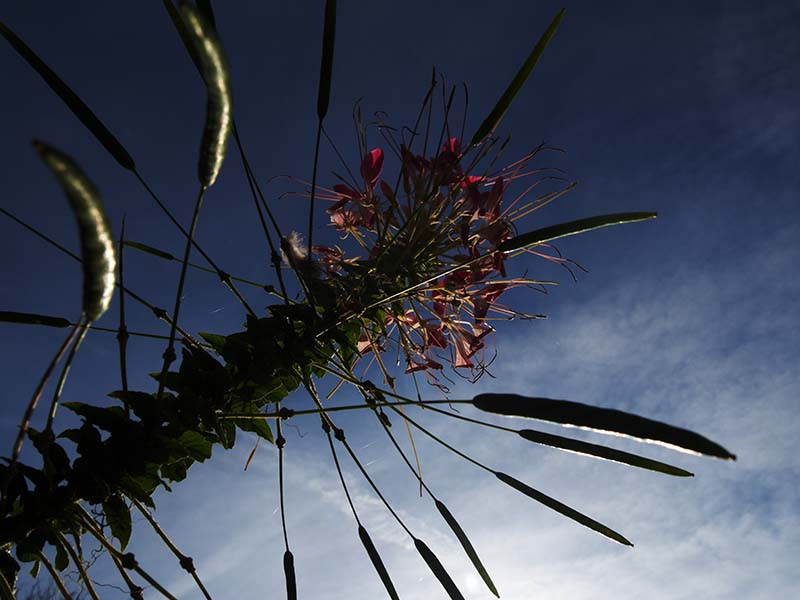
The seeds of this species are round, oval, or horseshoe shaped, and dark brown or black in color.
Cultivation and History
Rocky Mountain bee plant is native to western and central parts of the US and Canada, and has naturalized further east as well.
While it can be found growing in disturbed sites such as along ditch banks or roadsides, its natural habitats include dry meadows, prairies, woodlands, and even desert scrub.
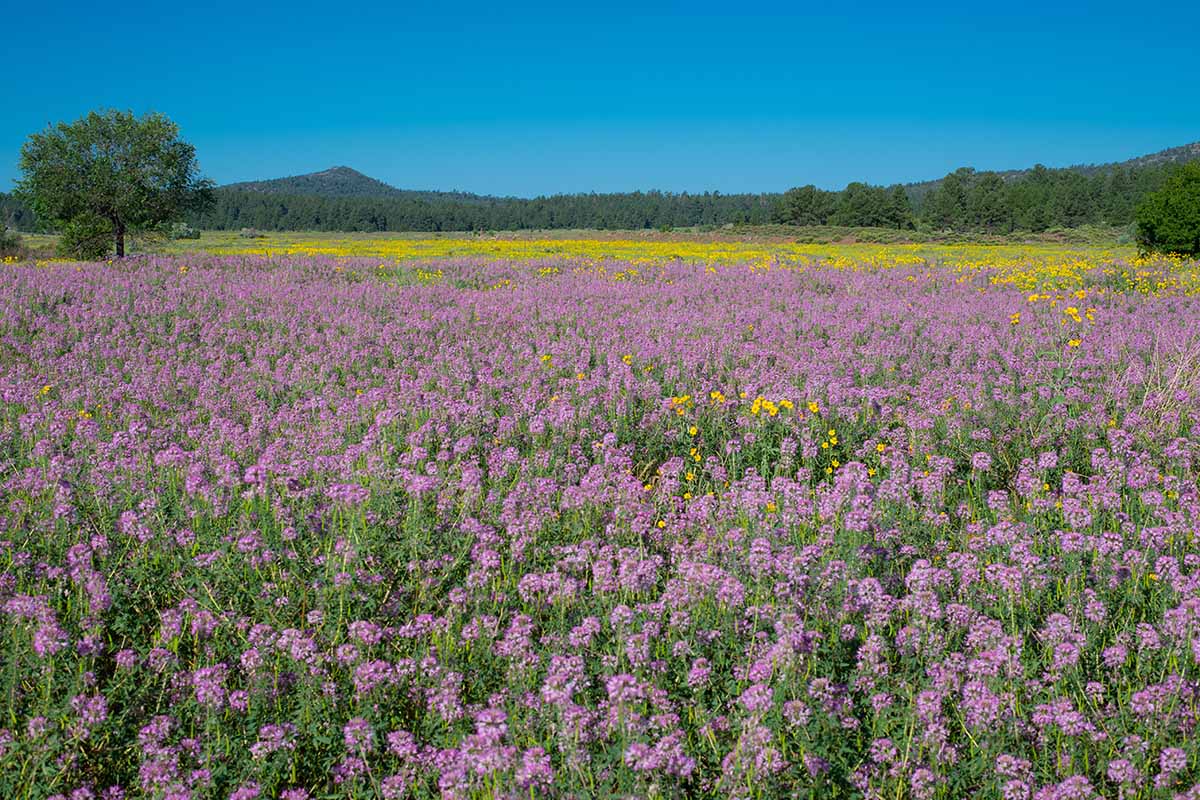
If you’ve ever perused benches of plants in a garden nursery, you will likely be familiar with one of this species’ relatives – the annual bedding flower, cleome (Cleome hassleriana).
Cleome looks very much like the subject of our article but is native to South America and has five to seven leaflets rather than the three of C. serrulata. Both of these species are members of the spiderflower family, or Cleomaceae.
Within that family, Rocky Mountain bee plant is classified botanically in a genus called Cleomella. These species are also known as the “stinkweeds.”
If you’re guessing there must be some reason for this nickname – you’re right. Some gardeners notice an unpleasant odor emanating from this species, which is also known as “skunkweed.”
Before getting pinned into place in the genus Cleomella, this species had some other taxonomic names, which are now considered synonyms. These include Cleome serrulata, Peritoma serrulata, and Atalanta serrulata.
Its much more expressive common names include “stinking clover,” “bee spider flower,” “bee spider plant,” “pink cleome,” “toothed spider flower,” and “Navajo spinach.”
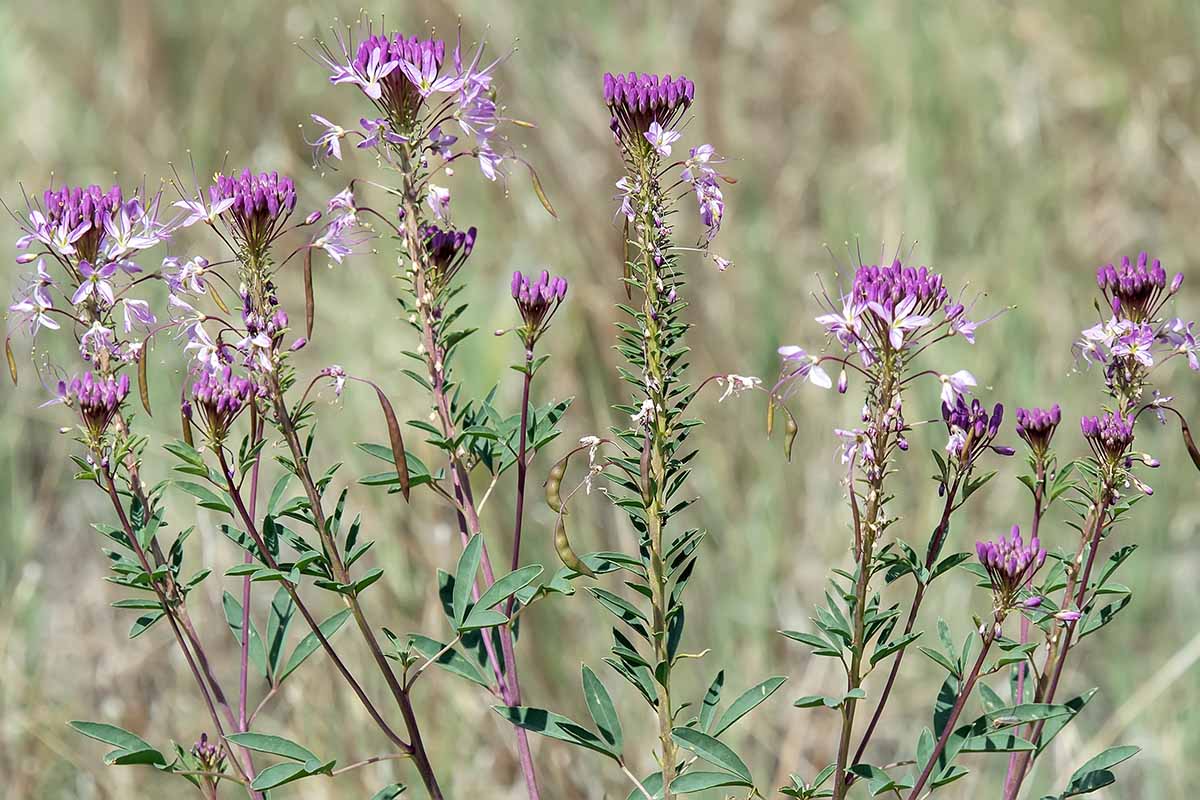
Does the term “Navajo spinach” make you wonder if this wildflower is edible? If so, the answer is yes!
C. serrulata has been used as a food by many Native American peoples, including (but not limited to) the Apache, Hopi, Navajo, and Zuni.
The leaves and flowers have been boiled and eaten as greens, as well as being dried and saved for winter for the same purpose. The seeds of this species have also been used for food, by drying and then grinding them into flour to make bread.
Various parts of the wildflower have also been used medicinally, and to make paint and dye.
The explorers Meriwether Lewis and William Clark collected the plant in 1804, and it was later classified botanically by Frederick Traugott Pursh in 1817.
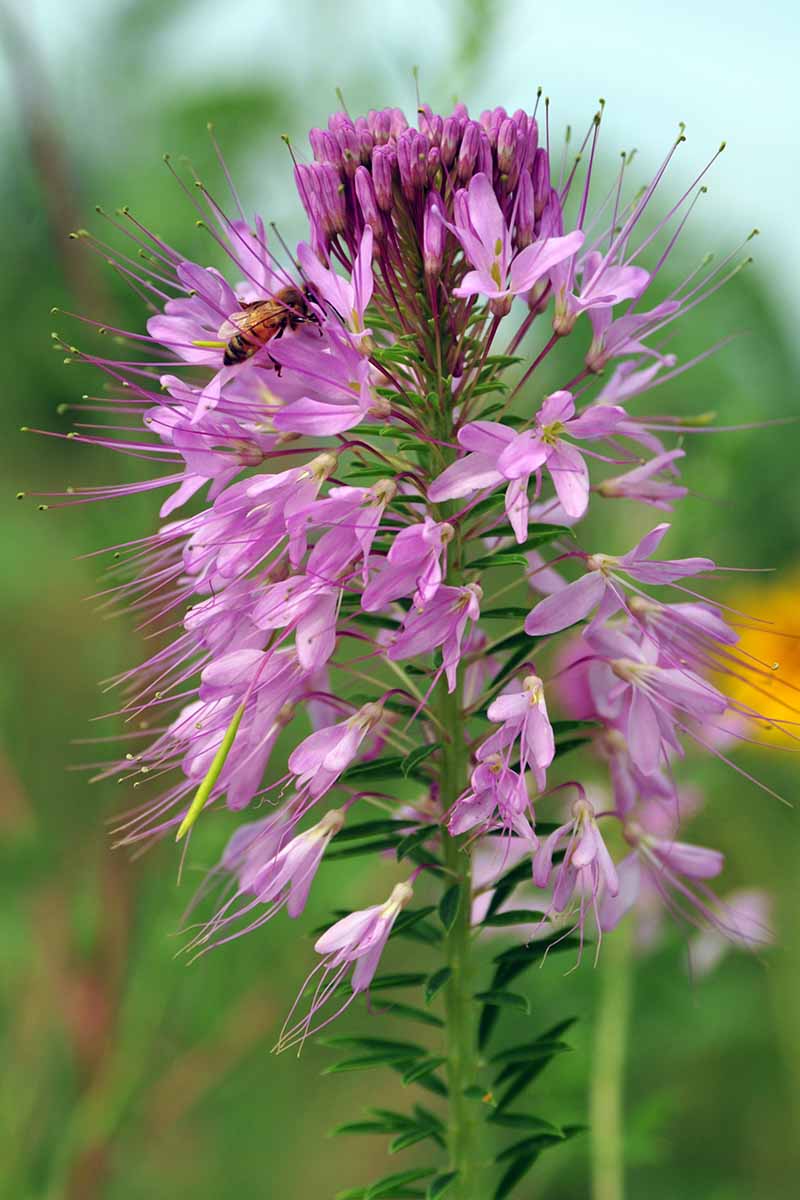
Of course, humans aren’t the only ones to appreciate these wildflowers for their many uses.
Their blooms attract many pollinators, and their seeds are enjoyed by various birds such as mourning doves (Zenaida macroura) and ring neck pheasants (Phasianus cochicus).
For those interested in growing it at home, this wildflower is suited to USDA Hardiness Zones 3 to 8.
Rocky Mountain Bee Plant Propagation
As an annual, bee spider flower is propagated from seed. It can either be sown directly outdoors, or started in an indoor location such as a greenhouse and then transplanted out later.
Whichever method you choose, you’ll need to either stratify seeds first, or sow them in the fall – they require a period of moist cold before they can germinate.
Also, check your seed supply and use only dark-colored seeds, since pale ones tend to not be viable.
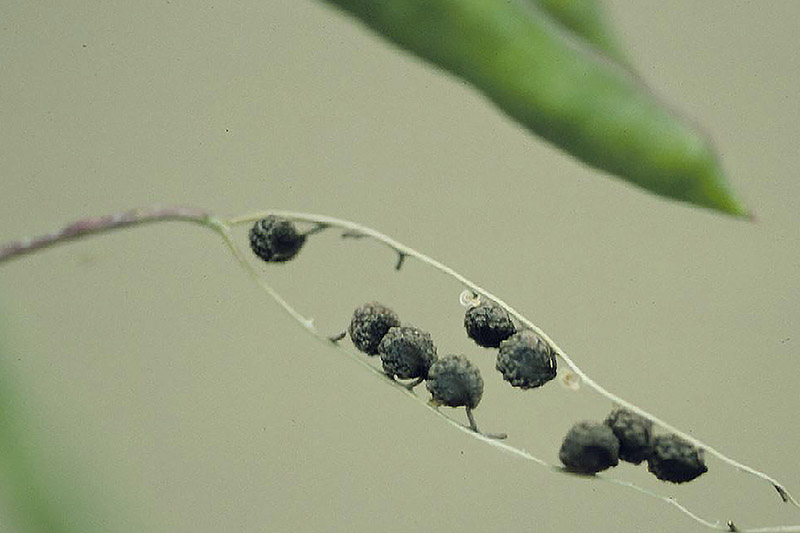
Fall sowing is a wise choice since these seeds require cold stratification, and also tend to germinate better with temperature swings.
If you miss your chance to sow seeds in the fall, you can artificially stratify seeds for spring planting.
To do this, mix seeds with moist sand and place in the refrigerator for two to six weeks. You might try taking this mixture out of the fridge during the day and returning it at night to replicate the oscillating temperatures that occur outdoors.
However, it’s worth noting that some gardeners manage to germinate seeds kept in greenhouse conditions at a steady temperature of 68°F in just five to 14 days.
Sowing Outdoors
When sowing outdoors in spring, aim to sow seeds six to eight weeks before your last average frost date.
First clear the planting area of weeds, then sow seeds 12 inches apart, barely covering the seeds with soil since they require light for germination. Keep the soil evenly moist.
If sowing in fall, you shouldn’t expect to see your seeds sprouting until next spring.
Read more about sowing seeds in the fall in anticipation of spring in our article!
For spring sowing, germination may take up to 35 days.
After germination, keep soil moist, but not soggy, until seedlings are four to six inches tall, at which point they can manage with less water.
Expect blooms approximately 70 days after germination.
Sowing Indoors
When sowing indoors, seeds can be sown much as discussed in the previous section, only rather than sowing them directly in the ground, you can sow them in small nursery pots.
After cold, moist stratification, these can be sown six to eight weeks before the last average frost date.
Leaving an inch between the surface of the soil and the rim of the pot, fill small, three-inch nursery pots with sterile seed-starting soil, such as this peat-free option from Organic Mechanics.

Organic Mechanics Seed Starting Blend 8-Quart Bag
You can purchase Organic Mechanics Seed-Starting Blend in an eight-quart bag from the Organic Mechanics Store via Amazon.
As for nursery pots, for this project it’s a good idea to use biodegradable ones such as CowPots in order to minimize damage to the specimens’ taproots during transplanting.
CowPots 3” Biodegradable Nursery Pots
You’ll find three-inch biodegradable CowPots available for purchase in packs of 12, 400, or 1,176 from Arbico Organics.
Sow one seed in each nursery pot, just barely covering it with growing medium.
Keep the medium moist as seedlings germinate. To avoid the risk of waterlogging the soil, use a spray bottle to water. Soggy soil can lead to a loss of seedlings due to damping off.
Germination may be quick in as little as five days, or slow at 35 days.
Once seedlings germinate, you may wish to start watering with a houseplant watering can instead of a spray bottle.
When the last average frost date approaches, start to harden the seedlings off in preparation for transplanting them outdoors.
You can learn more about hardening off in our article on sowing annuals indoors.
Once seedlings are hardened off, they will be ready to transplant.
Transplanting
For specimens that you have purchased or seedlings you have started yourself, they will be safe to transplant once the risk of frost is clear and you have hardened the plants off.
Dig a hole the same depth as your seedling’s pot, and twice as wide.
If it’s a plastic pot, remove the seedling by tilting the plant downward. If the plant is rootbound, you may need to squeeze the sides of the pot to release the roots.
Once removed from the nursery pot, if the plant is rootbound, rub the flat of your palm against the roots to gently loosen them up. If any excess soil falls from the nursery pot, mix it with the soil removed from the hole.
If it’s growing in a biodegradable pot, break the rim off so that it won’t stick up above the soil.
Place the transplant into the hole, taking care not to bury the crown of the plant with soil. Backfill with the removed soil, and pat gently around the transplant.
Water in the transplant, and provide irrigation if rainfall is absent until the plant is established, for at least a week or so.
How to Grow Rocky Mountain Bee Plants
When you’re ready to start growing Rocky Mountain bee plant, look for an open location since this wildflower is not highly competitive with its neighbors.
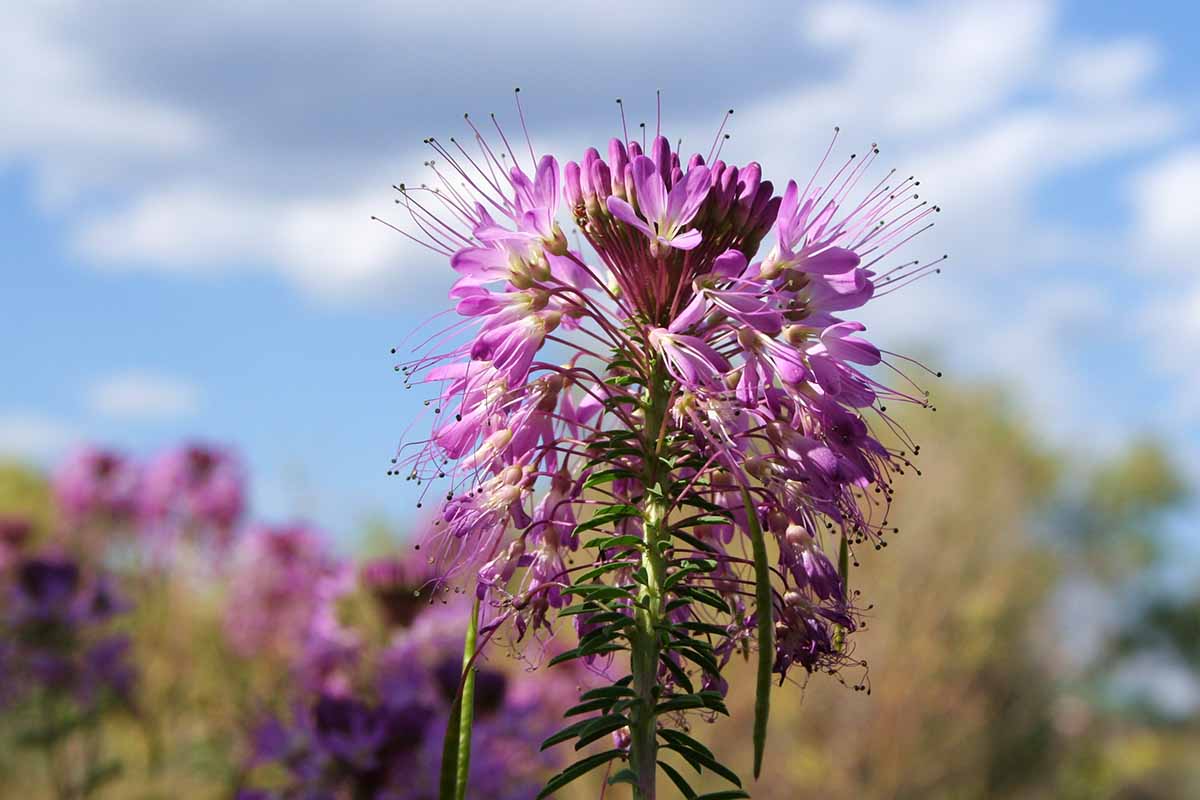
Bee spider flower requires well-draining soil, but it can grow in a variety of unamended soil conditions – in soil that is moist to dry, with a pH 6.0 to 7.6, and in sandy, clay, gravel, or loamy soils.
As for light, this plant can grow in full sun or part shade, though full sun is preferable.
Once established, bee spider flower does not require a lot of water – in fact, it can survive in locations that receive only eight to 10 inches of water per year. But if more water is available, growth will be better.
Growing Tips
- Grow in full sun to part shade.
- Provide irrigation if there’s no rain, until plants are established.
- Choose an open location to prevent pressure from nearby plants.
Pruning and Maintenance
One of the benefits of growing native wildflowers is that, when grown in their native regions, they often perform beautifully without much work – and that’s the case with the subject of our article.
Rocky Mountain bee plant doesn’t require fertilizer but it will benefit from mulching to conserve water.
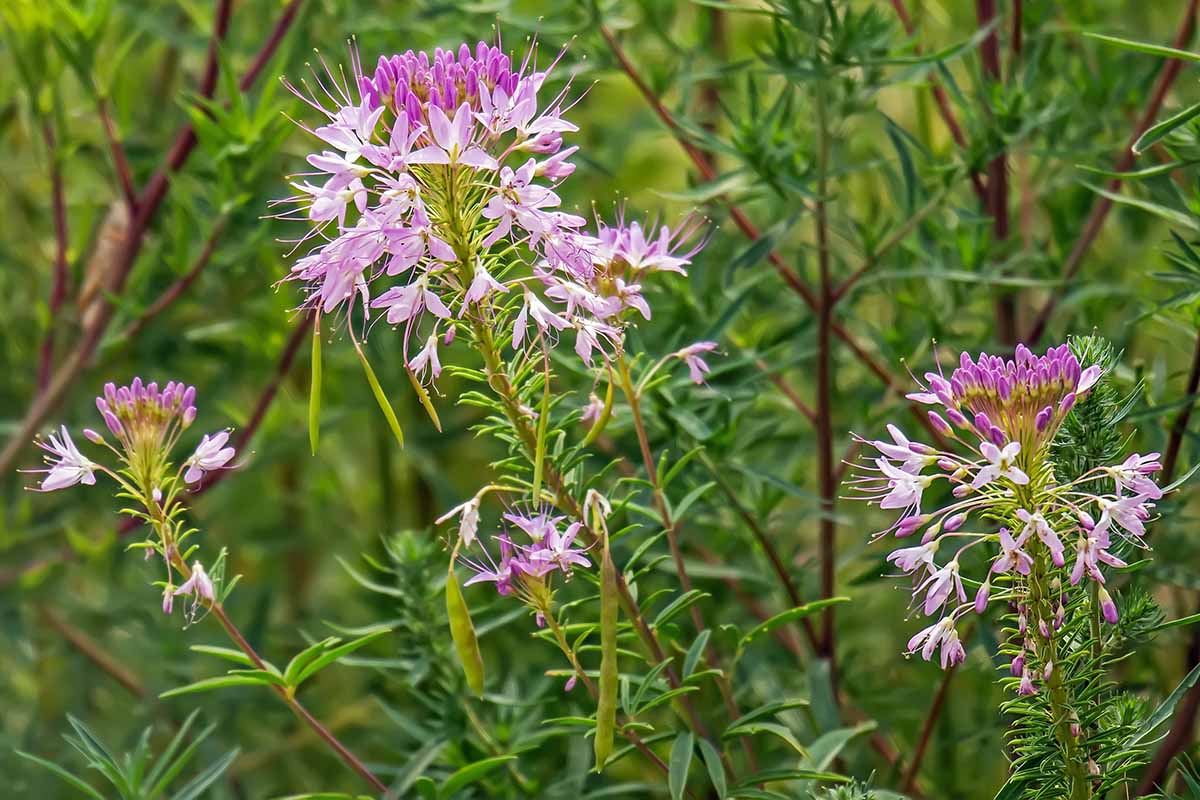
While plants are getting established, it’s important to keep the area weed-free.
If this is a gardening chore you’re dreading, read our article to learn how you can spend less time weeding!
While these plants don’t require pruning, if you’d like them to develop a bushier growth habit, the growing tip can be pruned back a few inches.
To prevent self-seeding, collect seed pods from plants before they begin to split.
On the other hand, if you’d like to save seeds, know that once the pods begin to split, the seeds are mature. Be sure to collect seeds from different specimens to ensure genetic diversity.
Spread on a screen to continue drying. Once seeds are dry, remove from the pods, and store in a seed envelope in a cool, dry spot. Seeds will stay viable for five years or more when correctly stored.
Expect plants to die back with the first frost.
Where to Buy Rocky Mountain Bee Plants
Bee spider flower may have a fairly wide native range, but it’s not a species you’ll often see in the nursery section of your local big box store.
To purchase live plants, check with the local chapter of your state’s native plant society or inquire with local botanical gardens to ask about upcoming native plant sales.
For seeds, you’ll be most likely to find these on offer from seed purveyors that carry or specialize in species native to North America.
One place you can find Rocky Mountain bee plant available for purchase online is from Earthbeat Seeds – they have this native on offer in packs of fifty seeds.
Managing Pests and Disease
When it comes to growing native wildflowers, oftentimes pest and disease problems are of little concern, and luckily that is the case with C. serrulata!
This species has a somewhat unpleasant odor, so deer and rabbits are not particularly attracted to this plant and won’t be likely to make it one of their favorite nibbling stations.
Birds will enjoy eating the seeds, but even if you are hoping to save seeds for future sowings, there will be plenty to share.
Rarely, gardeners report damage caused by flea beetles to the foliage of these wildflowers. In the unlikely event that this occurs in your crop of wildflowers, you’ll notice tiny holes in the leaves, most likely when plants are smaller.
You can learn more about controlling flea beetles in our article.
This species is a host to various species of larval moths, so don’t be surprised if some caterpillars make a meal of the foliage.
Damage will likely be minimal and may even be unnoticeable. And remember that after all, putting up with this is all in the name of supporting one’s local wildlife!
As for diseases, bee spider flowers are usually disease-free. However, when grown in monocultures, fungal diseases like leaf spot can be a problem.
The best way to handle this disease is via prevention.
Allow plants adequate spacing to ensure proper airflow, and water at the soil level instead of using sprinklers or holding a watering wand over the tops of plants. Keeping the plant’s foliage dry will make fungal diseases less likely.
Best Uses for Rocky Mountain Bee Plants
Bee spider flowers have a myriad of uses in the home landscape.
Since their water needs are low, they make excellent annuals to incorporate into a xeriscaped yard.
They can also be grown as part of a cut flower garden, but be forewarned that the flowers can have a strong odor that some people don’t like.
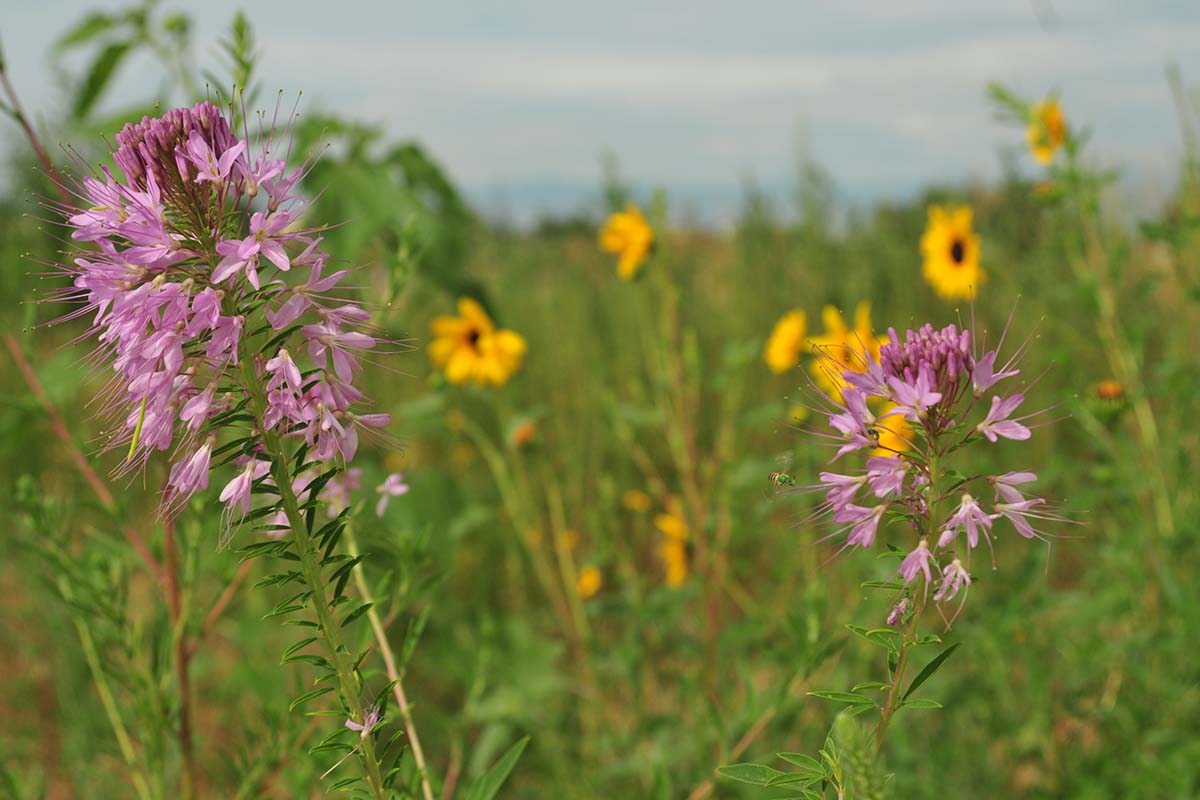
Bee spider flowers may be included as part of a native plant garden, especially in combination with blanket flower, sunflowers, prairie June grass, upright prairie coneflower, or sagebrush.
From a design point of view, these tall wildflowers are an excellent option to layer behind shorter shrubs or flowers. But since they naturalize easily via self-sowing, be sure to grow them where you want to keep seeing them year after year.
If one of your motivations for growing this species is to help your local wildlife, know that, just as its name suggests, this wildflower makes an excellent nectar source for all sorts of bees, including honeybees.
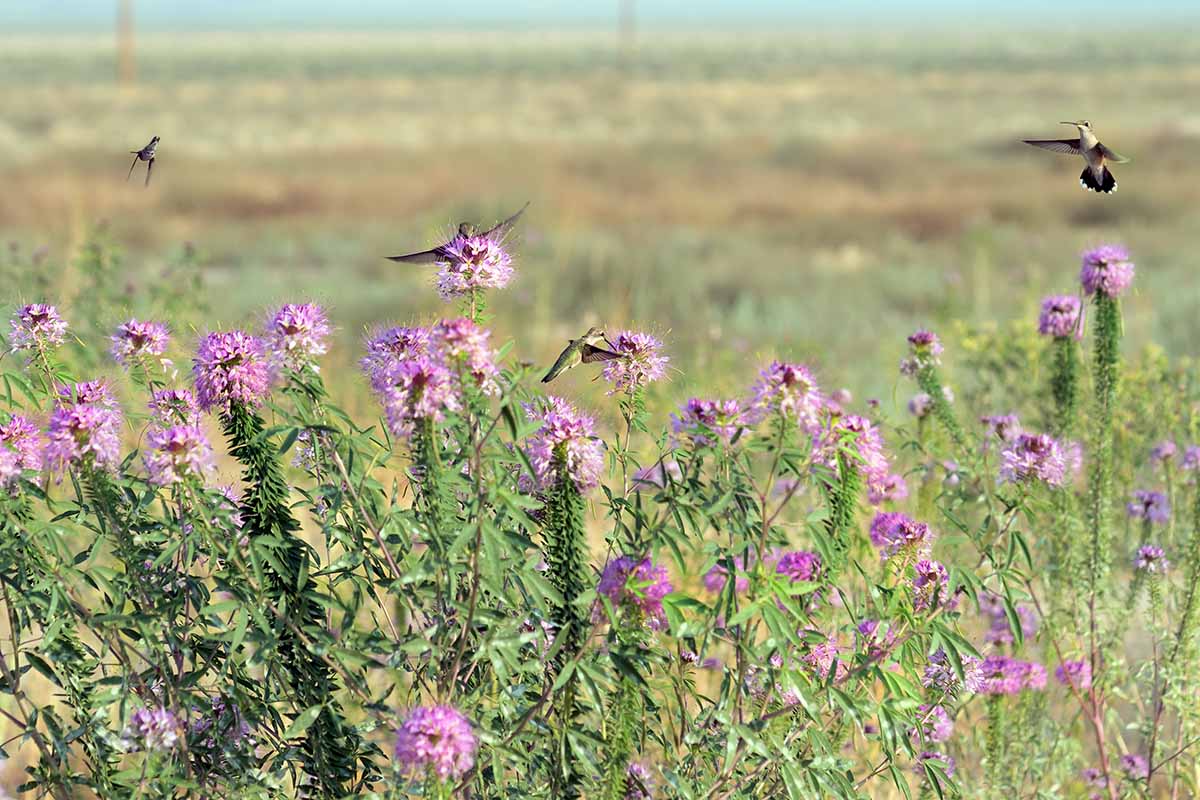
And if you’re also hoping to attract hummingbirds to your yard, this is a plant they’ll love!
Of course, hummingbirds and bees aren’t the only fans of these flowers. This species is also excellent for attracting and providing food for butterflies, including monarch butterflies (Danaus plexippus).
But providing wildflowers for beneficial insects isn’t just about the nectar.
C. serrulata is a larval host for the white-lined sphinx moth (Hyles lineata) and the checkered white moth (Pontia protodice). Yes, these caterpillars might nibble on your plants’ foliage, but you likely won’t even notice.
In addition to attracting and helping local pollinators, bee spider flowers can also be used for restoring landscapes after fire, as well as for site restoration.
In the western United States, Rocky Mountain bee plant has been shown to compete with nasty invasive weeds such as Halogeten glomeratus.
Quick Reference Growing Guide
| Plant Type: | Annual flower | Flower/Foliage Color: | Pink, purple, white / green |
| Native to: | Western and central US and Canada | Maintenance: | Low |
| Hardiness (USDA Zones): | 3-8 | Tolerance: | Drought, poor soil, soils high in calcium carbonate such as lime and chalk |
| Bloom Time: | May-October | Soil Type: | Sand, clay, gravel |
| Exposure: | Full sun, part shade | Soil pH: | 6.0-7.6 |
| Time to Maturity: | 70 days | Soil Drainage: | Well-draining |
| Spacing: | 12 inches | Attracts: | Bees, butterflies, hummingbirds, moths, wasps |
| Planting Depth: | Barely cover with soil (seeds), soil level (transplants) | Companion Planting: | Blanket flower, coneflower, Idaho fescue, plains coreopsis, prairie June grass, sage brush, showy milkweed, sunflowers |
| Height: | 4-79 inches | Uses: | Honey bee forage, hummingbird gardens, insectaries, naturalizing, pollinator gardens, site restoration, xeriscaping |
| Spread: | 12-36 inches | Family: | Cleomaceae |
| Water Needs: | Low | Genus: | Cleomella |
| Common Pests and Disease: | Flea beetles; leaf spot | Species: | Serrulata |
Let Your Garden Bee the Change
You should now feel ready to grow these wildflowers and enjoy their benefits: pollinators galore, showy and low maintenance flowers, and many more seasons of the same as these reseed.
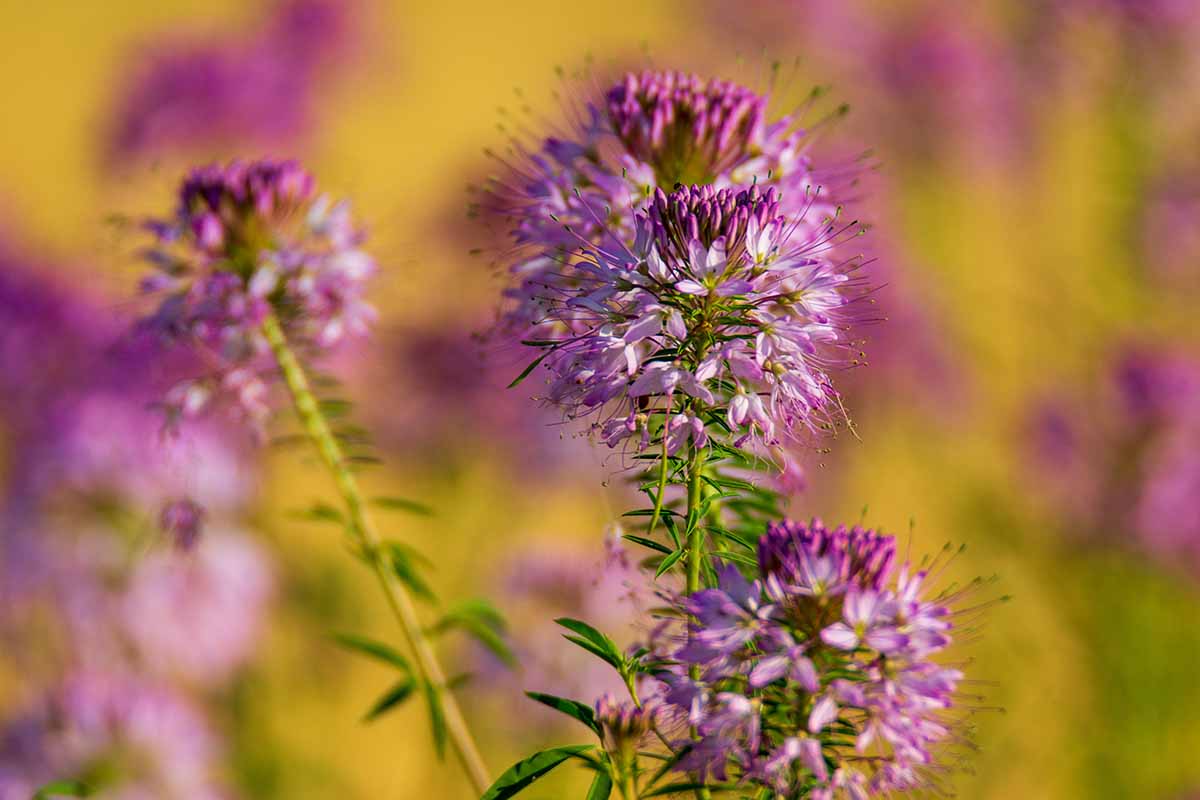
What’s your motivation for growing Rocky Mountain bee plant? Do you have any special connection with these flowers you’d like to share with our readers?
Please feel free to make use of the comments section for questions, stories, or fond memories – you’ll find it below!
Are you ready to welcome bees, butterflies, and other pollinators to your yard? Here are more articles to help you with that noble project:
